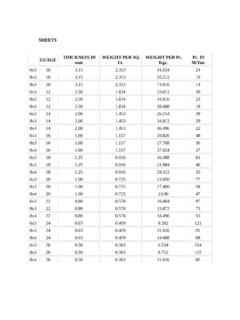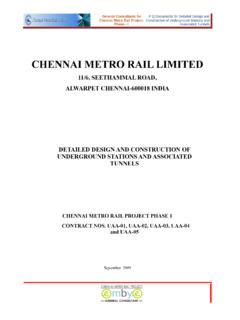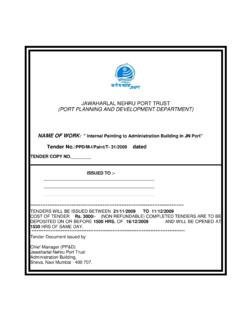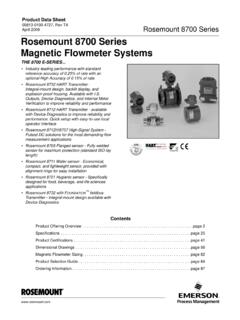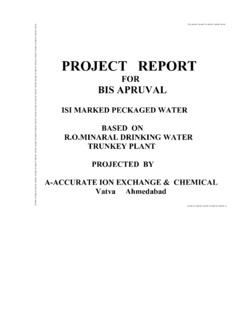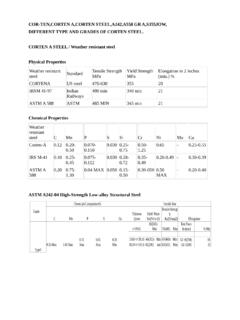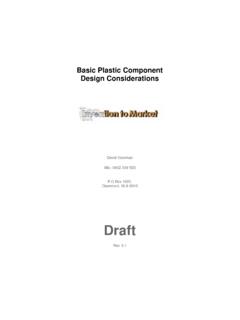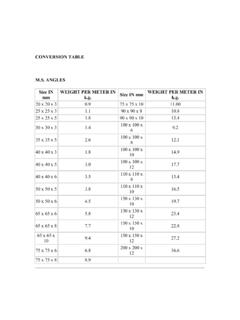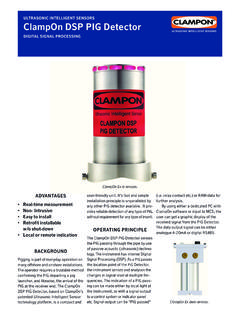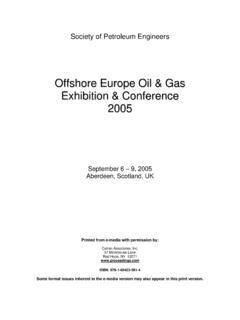Transcription of ULTRASONICINTELLIGENTSENSORS ClampOnDSPCorrosion-
1 ULTRASONIC INTELLIGENT SENSORSC lampOn DSP Corrosion-Erosion MonitorDIGITAL SIGNAL PROCESSINGULTRASONIC INTELLIGENT SENSORSP rinciple of operationThe working principle of the ClampOn CEM isbasedontransmittingultrasonic signals thatpropagate through the pipe-wall. The dis-persivecharacteristics ofa groupofguidedacoustic waves, called Lamb modes, areexploited to indicate a mean change in wallthickness relative to reference values acqui-redduring the installation ofthe CEM permanently installed CEM systemensures that measurements are repeatedfrequently and in exactly the same manner,thereby eliminating the weaknesses ofmanual ultrasonic thickness thickness trends are generated auto-matically and can be observed in real Corrosion-Erosion Monitor consistsof a Head Unit and up to eight smaller trans-ducers. The Head Unit processes and con-trols the signals, communicating with theelectromagnetic ultrasonic transducerswhich are fixed to the selected pipe signal path follows the metal structureThe patented ClampOn DSP Corrosion-Erosion Monitor (CEM) has been designed to monitor the averagewall thickness of pipes, containers and any large object that requires corrosion/erosion ClampOn CEM system utilizes a unique method of monitoring wall thickness loss by the use ofclamp-on sensors.
2 A number of transducers measure corrosion-erosion by transmitting ultrasonicsignals that propagate through pipe material. Using ClampOn acoustic transducers means that nodrilling or welding that would cause loss of production is DSP Corrosion-Erosion Monitorbetween the transceivers in operation,generating a matrix of measurements withthickness information. The number of HeadUnits and transducers to be used is decidedby the client in consultation with has shown the ClampOn CEM tobe both physically robust and capable ofwithstanding changes in pipe system is capable of performing mea-surements on pipe diameters from 50 mm(2")andupwards andonmaterial thicknessesranging from 4 mm to 35 mm ( " ").Changes inaveragewall thickness ofas little as 1% can be measured in real signal path follows the metal struc-ture between the transducers in operation,which in turn generates a matrix of all the ClampOn CEM system is quickand simple. Two to eight transducers arefixed to the pipe surface (or other metalplate structure) and connected to the HeadUnit, which continuously sends and receivesguided waves between the transducers,resulting in a network of measurement pathsthat covers the selected given pair of transducers covers morearea than is defined by the transducer di-mensions.
3 Figure 1 shows a schematic dia-gram (top view) of the ultrasonic beamwidth for a pair of transducers separatedby approximately 400 a CEM installation with six transducersin operation the coverage area is large, (seeFigure 2), covering 60% of the pipe circum-ference. The transducers have separationsof 700 mm and the pipe is 8 in CEM monitors continuously in realtime or according to chosen to a control system the CEM willprovide trends and alarms, enabling theoperator to evaluate how trends in corrosionor erosion are related to other CEM transducers are after installationhidden by a protective AREASAFE AREAHEAD UNITHEAD UNITJUNCTIONBOXC lampOn DSPC orrosion-Erosion MonitorClampOn DSPC orrosion-Erosion Signal Signal BarrierLOCALCOMPUTERWITHCLAMPONSOFTWAREC lientInterfaceTypicalsystemset-upFigure 2. CEM coverage area on an 8 OD pipe, with a total separationof 700 mm and a six-transducer set-up, giving a total coverage of ap-proximately 60%.Figure 1. Approximate beam width and profile as estimated by 2D mo-dels for a representative transducer representationof coverage areaProduct specificationsULTRASONIC INTELLIGENT SENSORP rinciple of operationUltrasonic intelligent sensor, Active ultrasound, guided wavesSensor electronicsDSP 66 MIPS, A/D converter 24bit, 5MS/sec, 0-1 MHzSensor electronics input 2 MHzSensor electronics output20-1500 KHz, 70 VoltInputs8 consumptionNormal operation: WSelf testingYesSensor outputDigitalINTRINSICALLY SAFE APPROVALATEXII2 (2) G Ex mb [ib] IIC T4, Zone 1II2 (2) G Ex ib mb [ib] IIB T4, Zone 1 Enclosure standardIP67 Enclosure materialAISI 316 Stainless SteelDimensions / Weight240 mm x 180 mm x 155 mm/ 6 kg (13,2 lbs)Max.
4 Pipe surface temperature-40 to 180 C (-40 to 356 F)Operating pipe temperature-40 to 150 C (-40 to 302 F)Method of installationHead Unit to be placed near pipe, transducers to be in contact with pipeInterface optionsRS485 Two-way communicationYesSoftware upgradableYesSensor configurationUp to 8 transducersDistance to main sensor (6 - 40 )Coverage distance max. 2 m (80 )CORROSION & EROSION MONITOR TECHNICAL DATAPipe diameterMin OD 75mm (3 )Pipe-wall thickness4 to 35mm (0,157 to 1,378")Pipe OD /wall thickness> 8 Distance between to 2mResponse timeReal-timeSensitivity1% of wall thickness. The presence of liquid in the pipe does notaffect sensitivityFrequency range20 to 1500 kHzFluid in pipeOil, gas, water, multiphase or other liquidsPipe materialAll metal pipesCalibrationOnce, on installationCable interfaceCable with connector/Flying lead/Gland for cable accessCablingMinimum 4x mm2 (pending system configuration)COMPUTER / CONTROLLERM inimum hardwareComputer: Pentium III (or equivalent) with 512 MB RAMC ontroller.
5 Fieldpoint or RIO Programmable Automation Controller (PAC)Software requirements forWindows XP/Vista/2000-2008 ClampOn s softwareInputSerial, Modbus, Ethernet, OPCS ignal outputSerial, Modbus, Ethernet, 4-20mA, Relay, Client ServerSAFE AREA EQUIPMENTM ains power supply12 - 48 VDC or 100-260 VAC 50-60 HzPower ConsumptionMax per detector + computer rack moduleAreas of application Pipelines Pipe components Storage tanks Plate sections Corrosion detection Erosion detectionProduct advantages Non-intrusive Wide temperature range Not operator-dependent Covers large area of pipeline High sensitivity Easy to install Designed for lifetime operationTypical customers Refineries Chemical plants Process industry Power plants Oil and gas industry Transport linesIntelligence andself-calibrationThe ClampOn Corrosion-ErosionMonitor self-tests the followingsystem parameters: input level,RAM, internal voltage, internaltemperatures, all internal busesand the AS, Damsgaardsvn.
6 131, NO-5160 Laksevaag, Bergen, Norway, Tel: +47 5594 8850, Fax: +47 5594 8855,The ClampOn Ultrasonic Intelligent Sensorprocesses all data inthe sensoritself(paten-ted principle), thus enabling the instrumentto discriminate between sand-generated andflow-generated noise. This is of importanceto the user since changes in flow rates andthe gas/oil ratio do not affect the perfor-mance of the good signal-to-noise (s/n) ratio is vitalfor quality measurements of this sort, andClampOn s sensors are the very best in thisrespect. With thenewversion,external noisehas been completely sensor has a memory capacity forstoringupto60daysofdata,andcanevenber eprogrammed to function either as a sandmonitor,a pigdetectorora corrosion-erosionmonitor for monitoring changes in SensorsThe subsea sensors were developed in closecollaboration with Shell Deepwater Develop-ment Inc. in Houston and FMC Energy Sys-tems in Norway. The successful outcome ofthe project was a sand monitoring systemthat combined an extremely long working lifewith excellent acoustic properties, and offer-ing a high degree of reliability in the ,ClampOn has supplied approximately 1000subsea sensors to the oil and gas subsea meters have been under con-tinuous development in order to optimizequality and performance, and to meet therequirements of the DSP Pig DetectorThe ClampOn DSP Pig Detector is a non-in-trusive pig detection system designedto act as a first-stage alarm system for pigdetection.
7 It provides accurate and reliableregistration of the time when a pig is pas-sing and transmits the signal to the detector can also indicate the amountof debris preceding the pig during SandQ & ClampOnDSP-06 Particle MonitorAll sensors are identical and interchange-able, which is a real advantage if sensorsneed to be moved/relocated or in case ofservice. The DSP s increase in processingcapacity enables the sensor to combinesignals from several frequency ranges whenanalysing the flow. ClampOn sensors areversatile, and are the only instruments onthe market that offer two-way communi-ca-tion between sensor and control solution enables future upgrades of thesensortobeinstalledvia a simple download ofnew software. When using digital outputfrom the sensors, they can be installed in a multi-drop sensor is installed after a bend,wheretheparticles (chalk orsand) areforcedout of the flow and impact the inside of thepipe wall, generating an ultrasonic ultrasonic signal is transmitted throughthepipe wallandis pickedupbytheacousticsensor - the leader in sand, pigand corrosion-erosion monitoringSince its beginnings in 1995, ClampOn AS has grown to be the largest supplier of passive ultrasonic systemsfor sand/particle monitoring to the international oil and gas sector.
8 All products supplied by ClampOn; particlemonitor, pig detector, corrosion-erosion monitor and leak monitor, are based on the same, well-proven techno-logy platform. Both topside and subsea instruments incorporate Digital Signal Processing (DSP), complete di-gitalization that eliminates analogue filters, circuits and :e-mail: -USA:ClampOn, Inc., 15720 Park Row, Ste. 300 (77084), PO Box 219206 (77218-9206), Houston, TX, USA,Tel: +1 281 492 9805, Fax: +1 281 492 9810, e-mail: : T nnes H. Gundersen Photo: Thor Westreb Print: Molvik Grafisk AS AUGUST 2009 ULTRASONIC INTELLIGENT SENSORS
